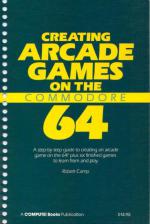
Computer Gamer
 1st October 1985
1st October 1985
Categories: Review: Book
Author: Jane Naylor
Publisher: Interface
Machine: Commodore 64
Published in Computer Gamer #7
Creating Arcade Games On The Commodore 64
This book is one for Commodore games freaks. If you are a bit fed up of just typing in other people's programs and feel like trying your hand at designing and programming a few of your own then here is a good place to begin. This is not for the complete novice however; you will need some knowledge of Basic although you do not need to know a thing about games programming. All will be revealed...
The book is divided into two parts. The first and main part explains how to develop an arcade game, and the second part contains a substantial example program with full explanations of each part.
The first chapter is concerned with controlling your Commodore 64. It explains all about the operating system and memory, then goes on to how to access the screen memory, before showing you how to produce sprite graphics and sound effects. Chapter 2 gets down to the theory of designing games with some thoughtful ideas about what features should be included.
The next chapter takes a detailed look at programming techniques, starting with how you should try to translate your ideas into action by planning first and coding second (not the other way round!). The last chapter in this section explores video effects and gives several examples of how to achieve effects such as missile graphics.
The second part of the book contains an arcade game called Molar Man - a whacky idea set in a human tooth where the unhappy player has to defend his enamel from the marauding gremlins of tooth decay. Dentists should love it. Seriously though, a lot of effort has been put into explaining the program in relation to the earlier parts of the book and this approach works very well.
The program is divded into modules and each one is printed out and explained separately, as well as being included in a complete listing at the end. This gives you a series of subroutines that you can adapt for your own programs as and when you want to.
The book provides a good package overall for the would-be games programmer: lots of theory backed up by examples. The author has gone to pains to try to explain sometimes quite complicated ideas as simply as possible and this works well by and large, although at times it does sound rather waffly.
Time passes slowly in the book world, and although I too am a fan of the Commodore 64, having one myself, I can't read comments like "64K is a lot of memory for a small computer" without wincing a bit. Other minor grouses are the complete lack of illustrations for a topic that is, after all, very visual and the fact the dot matrix printout was not of very good quality, being quite faint in places. It is now possible to photoset listings direct from disk in a proper typeface and publishers really should not be relying on patchy printout for books like this.
Overall, I think this book would be of interest to a lot of Commodore games people. It covers all the essential elements of designing and creating arcade games and should be a useful springboard to get you going on your own.
Scores
Commodore 64 Version| Overall | 71% |


